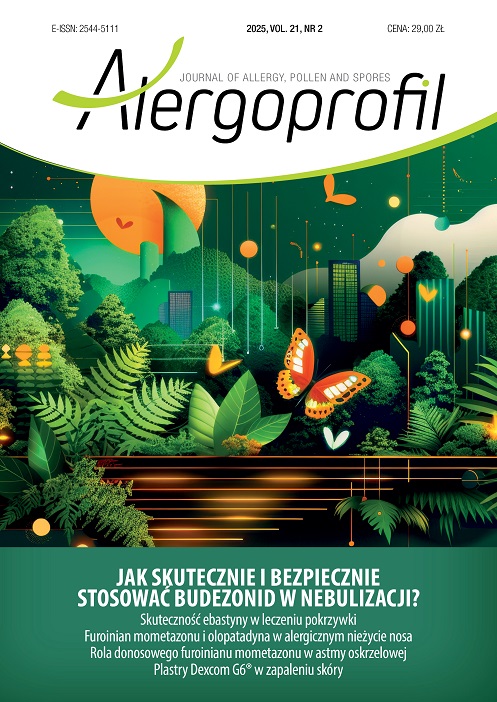The supportive role of intranasal mometasone furoate in controlling bronchial asthma Review article
Main Article Content
Abstract
Bronchial asthma and allergic rhinitis are chronic inflammatory diseases of the respiratory system with a common immunological ground based on the predominance of the Th2 response. The presence of allergic rhinitis significantly increases the risk of developing bronchial asthma, and the coexistence of these two conditions adversely affects symptom control, exacerbation frequency, and quality of life of patients. Contemporary pathophysiological concepts assume the existence of a close functional and immunological relationship between the upper and lower respiratory tract. Chronic inflammation in the nose can initiate and sustain an inflammatory response in the bronchi, thereby worsening the course of allergic rhinitis.
Mometasone furoate, a new-generation intranasal glucocorticosteroid, has a strong anti-inflammatory effect with minimal systemic bioavailability. It inhibits key inflammatory cytokines (IL-4, IL-5, IL-13), reduces eosinophil infiltration, and improves nasal mucosal function. Numerous studies have shown that its use in patients with allergic rhinitis and concomitant bronchial asthma improves respiratory parameters, reduces asthma symptoms, decreases the need for as-needed medication, and improves quality of life.
The article reviews current data on the supportive role of mometasone furoate in the treatment of bronchial asthma in the context of integrated care. The importance of early intervention, especially in children, is also emphasized in the context of the possible impact of chronic nasal obstruction on the morphological development of the facial skeleton.
Downloads
Article Details

This work is licensed under a Creative Commons Attribution-NonCommercial 4.0 International License.
Copyright: ? Medical Education sp. z o.o. This is an Open Access article distributed under the terms of the Attribution-NonCommercial 4.0 International (CC BY-NC 4.0). License (https://creativecommons.org/licenses/by-nc/4.0/), allowing third parties to copy and redistribute the material in any medium or format and to remix, transform, and build upon the material, provided the original work is properly cited and states its license.
Address reprint requests to: Medical Education, Marcin Kuźma (marcin.kuzma@mededu.pl)
References
2. Samoliński B, Raciborski F, Lipiec A et al. Epidemiologia chorób alergicznych w Polsce (ECAP). Alergol Pol. 2014; 1: 10-8.
3. Nur Husna SM, Tan HT, Md Shukri N et al. Allergic Rhinitis: A Clinical and Pathophysiological Overview. Front Med (Lausanne). 2022; 9: 874114. http://doi.org/10.3389/fmed.2022.874114.
4. Ogulur I, Mitamura Y, Yazici D et al. Type 2 immunity in allergic diseases. Cell Mol Immunol. 2025; 22: 211-42. http://doi.org/10.1038/s41423-025-01261-2.
5. Samoliński B, Arcimowicz M, Buczyłko K et al. Polskie Standardy Leczenia Nieżytów Nosa (PoSLeNN). Medycyna Praktyczna, Kraków 2013.
6. Grzanka A, Misiołek M, Golusiński W et al. Molekularne mechanizmy działania glukokortykoidów: implikacje w leczeniu zapalenia zatok i polipów nosa. Eur Arch Otorhinolaryngol. 2011; 268: 247-53.
7. Herxheimer H. Should corticosteroid aerosols be used in severe chronic asthma? Thorax. 1981; 36(6): 401-3. http://doi.org/10.1136/thx.36.6.401.
8. Bousquet J, van Cauwenberge P, Khaltaev N et al. Allergic Rhinitis and its Impact on Asthma: ARIA workshop report. J Allergy Clin Immunol. 2001; 108(Suppl 5): 147-336.
9. Okano M. Mechanisms and clinical implications of glucocorticoids in the treatment of allergic rhinitis. Clin Exp Immunol. 2009; 158: 164-73.
10. Samoliński B, Sybilski A. Znaczenie stanów zapalnych błony śluzowej nosa w astmie oskrzelowej. Alergia Astma Immunologia. 2007; 12(1): 7-14.
11. Rogliani P, Laitano R, Ora J et al. Strength of association between comorbidities and asthma: a meta-analysis. Eur Respir Rev. 2023; 32(167): 220202. http://doi.org/10.1183/16000617.0202-2022.
12. Lohia S, Schlosser RJ, Soler ZM. Impact of intranasal corticosteroids on asthma outcomes in allergic rhinitis: a meta-analysis. Allergy. 2013; 68(5): 569-79. http://doi.org/10.1111/all.12124.
13. Baiardini I, Villa E, Rogkakou A et al. Effects of mometasone furoate on the quality of life: a randomized placebo- controlled trial in persistent allergic rhinitis and intermittent asthma using the Rhinasthma questionnaire. Clin Exp Allergy. 2011; 41(3): 417-23. http://doi.org/10.1111/j.1365-2222.2010.03660.x.
14. Price D, Kemp L, Sims E et al. Observational study comparing intranasal mometasone furoate with oral antihistamines for rhinitis and asthma. Prim Care Respir J. 2010; 19(3): 266-73. http://doi.org/10.4104/pcrj.2010.00040.
15. Global Initiative for Asthma. Global Strategy for Asthma Management and Prevention, 2025. Updated May 2025.
16. Brożek JL, Bousquet J, Agache I et al. Allergic Rhinitis and its Impact on Asthma (ARIA) guidelines ? 2016 revision. J Allergy Clin Immunol. 2017; 140(4): 950-8.
17. Daley-Yates PT, Richards DH. Relationship between systemic corticosteroid exposure and growth velocity: development and validation of a pharmacokinetic/pharmacodynamic model. Clin Ther. 2004; 26(11): 1905-19. http://doi.org/10.1016/j.clinthera.2004.11.017.
18. Charakterystyka Produktu Leczniczego. Pronasal, 50 mikrogramów/ dawkę.
19. Chohan A, Lal A, Chohan K et al. Systematic review and meta-analysis of randomized controlled trials on the role of mometasone in adenoid hypertrophy in children. Int J Pediatr Otorhinolaryngol. 2015; 79(10): 1599-608. http://doi.org/10.1016/j.ijporl.2015.07.009.
20. Silva D, Ansotegui I, Morais-Almeida M. Off-label prescribing for allergic diseases in children. World Allergy Organ J. 2014; 7(1): 4. http://doi.org/10.1186/1939-4551-7-4.
21. Jiramongkolchai P, Patel S, Schneider JS. Use of Off-Label Nasal Steroid Irrigations in Long-Term Management of Chronic Rhinosinusitis. Ear Nose Throat J. 2021; 100(5): 329-34. http://doi.org/10.1177/0145561321998521.
22. Sastre J, Mosges R. Local and systemic safety of intranasal corticosteroids. J Investig Allergol Clin Immunol. 2012; 22(1): 1.
23. Cingi C, Songu M. Nasal steroid perspective: knowledge and attitudes. Eur Arch Otorhinolaryngol. 2010; 267: 725-30.
24. Ant A, Kemaloglu YK, Yilmaz M et al. Craniofacial Deviations in the Children With Nasal Obstruction. J Craniofac Surg. 2017; 28(3): 625-8. http://doi.org10.1097/SCS.0000000000003409.
25. Dąbrowski A. Niedrożność nosa ? przyczyny, diagnostyka i leczenie. Lekarz POZ. 2017; 1: 19-28.

